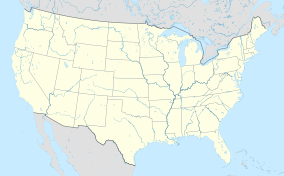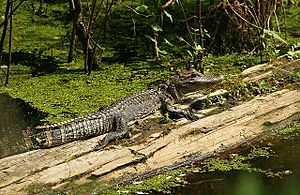Yazoo National Wildlife Refuge facts for kids
Quick facts for kids Yazoo National Wildlife Refuge |
|
|---|---|
|
IUCN Category IV (Habitat/Species Management Area)
|
|
| Location | Washington County, Mississippi, United States |
| Nearest city | Hollandale, Mississippi |
| Area | 12,941 acres (52.37 km2) |
| Established | 1936 |
| Visitors | 144,710 (in 2004) |
| Governing body | U.S. Fish and Wildlife Service |
| Website | Yazoo National Wildlife Refuge |
The Yazoo National Wildlife Refuge is a special place in Washington County, Mississippi. It covers a huge area of about 12,941 acres (52.4 square kilometers). This refuge was created to protect and provide a home for many different birds. It's especially important for waterfowl and other birds that travel long distances along the Mississippi Flyway. They use the refuge for nesting, finding food, raising their young, and resting during their journeys.
The refuge is named after the Yazoo tribe, who lived in this area a long time ago. It also serves as the main office for the Theodore Roosevelt National Wildlife Refuge Complex. A team of eleven people works hard to take care of the refuge.
Contents
A Look Back: History of the Refuge
In the early 1900s, this area was a great spot for hunting ducks, geese, and swans. There were lots of these birds during the winter. Hunters would even travel from far away places like New England to hunt here.
How the Refuge Started
The idea to create the refuge began in 1936. The government started buying land to protect the birds. The first purchase was 2,166 acres (8.77 square kilometers). Soon after, in 1937, they bought another 639 acres (2.59 square kilometers). The plan was to eventually get 20,000 acres (80 square kilometers).
For many years, from 1936 to 1956, the refuge didn't have a staff working there full-time. The main office building for the refuge was finally built in 1959.
Growing the Refuge
More land was bought in the 1960s. By July 30, 1969, the refuge had grown to 12,471 acres (50.5 square kilometers). As more land was added, the refuge staff began to manage the land for different animals. They helped mourning doves, wood ducks, Canada geese, and other wading birds. They also worked to protect endangered species.
In 1970, a group of wild turkeys was brought to the refuge. This helped to start a new population of turkeys there. The refuge grew even more in 1992 when another 470 acres (1.9 square kilometers) were purchased. This brought the total size of the Yazoo National Wildlife Refuge to its current 12,941 acres (52.4 square kilometers).
The Land and Its Features
The Yazoo National Wildlife Refuge has a varied landscape. The ground is made of different types of soil, from heavy clay to softer silt loam. There are also some small sand ridges. Most of the farm areas here have very good soil for growing crops. The land's height changes quite a bit, from about 90 feet (27 meters) in low, wet areas to 113 feet (34 meters) in higher farm fields.
Swan Lake: A Special Oxbow Lake
A very important part of the refuge is Swan Lake. This lake covers over 4,000 acres (16 square kilometers). It's an oxbow lake, which means it formed thousands of years ago. Back then, the Mississippi River changed its path, leaving behind this curved section of its old riverbed.
In the past, another stream called Silver Lake Bayou flowed into Swan Lake. This caused a lot of dirt and mud (silt and sediment) to build up, making the lake shallower. To fix this, the Corps of Engineers built a new channel. This new channel now sends the muddy water around Swan Lake and into Steele Bayou. This project helps keep Swan Lake from filling up with too much dirt, keeping it at a good depth for wildlife.
Water Management and Habitats
The way the Mississippi River moved long ago created a "ridge-and-swale" pattern on the refuge. This means there are higher ridges and lower, wetter areas. This mix of high and low land creates many different homes (habitats) for wildlife. The refuge staff has used this natural landscape to create over 70 water areas called impoundments. They did this by installing 96 water control structures. These impoundments provide homes for migratory waterfowl, wading birds, alligators, and many other animals.
Since 1968, about 2,000 acres (8 square kilometers) of old farmland have been replanted with trees. This process is called reforestation. They planted over 20 different kinds of trees, using both acorns and young tree seedlings. These planted forests are some of the oldest of their kind. They help scientists study how bottomland hardwood forests grow back over time. This reforestation work at Yazoo National Wildlife Refuge has inspired similar projects on other refuges and private lands across the southeastern United States.
The refuge has many different types of habitats. These include bottomland hardwood forests, cypress swamps, and farm fields. A main goal is to provide food for the many waterfowl that spend the winter here. Sometimes, more than 250,000 birds use the refuge! They eat crops like corn, milo, rice, and wheat, as well as natural wetland plants.
Amazing Wildlife and Protected Species
The refuge has a special area called the Cox Ponds. These were once catfish ponds that were no longer used. The refuge reshaped them to create 14 ponds, each with its own water control system. This allows the staff to manage the water levels perfectly. These ponds are a great home for waterfowl, shorebirds, and other water birds.
Birds of the Cox Ponds
Many different birds visit the Cox Ponds. You might see white ibis, glossy ibis, little blue and great blue herons, great egrets, and snowy egrets. There are also many kinds of dabbling and diving ducks in the winter. From July to November, about 20 species of shorebirds stop here on their journey south.
In 2003, the first group of black-bellied whistling ducks ever seen in Mississippi was photographed here. By 2004, more of these tropical ducks were observed, showing their population was growing.
Wood Duck Nesting Program
The refuge has a very successful program for wood ducks. They set up many nest boxes, which help about 2,000 wood duck ducklings hatch each year. Staff check these boxes often during nesting season.
Other Animals You Might See
Besides birds, the refuge is home to many white-tailed deer. You can also find wild turkeys, bobcats, and otters. The American alligator is a common sight in the refuge's lakes and swamps. You might see them basking in the sun on logs or floating quietly in the water. Sometimes, the endangered Louisiana black bear is also seen here.
Fun Things to Do and See
The Yazoo National Wildlife Refuge offers great chances to see wildlife. There are two special areas designed for observing animals:
- The Holt Collier Boardwalk and Observation Tower: This is a 0.25-mile (0.40-kilometer) boardwalk trail. It leads to a platform where you can look out over Lizard Lake. From here, you can safely watch pied-billed grebes, moorhens, wading birds, wood ducks, and American alligators.
- Alligator Pond: This tower gives you excellent views of alligators, purple gallinules, moorhens, green herons, and other wildlife.
Many visitors love seeing the American alligator. You can often spot them on warm spring days. Good places to look for alligators include Holt Collier Horseshoe Pond, Alligator Pond, Lizard Lake, Deer Lake, and Alligator Alley.
Hunting and Fishing Rules
The refuge allows hunting for white-tailed deer, squirrels, rabbits, and raccoons. The deer hunts, especially with muzzleloaders and bows, are very popular. However, because the refuge was created to protect migratory waterfowl, hunting ducks is not allowed here.
You cannot use ATVs on the refuge roads or trails. However, all refuge roads are open for walking, unless a sign says otherwise.
Fishing is not allowed at the refuge. This is because certain substances found in the water, fish, and mud samples could be harmful if eaten, making it unsafe for people to fish and eat the fish.



